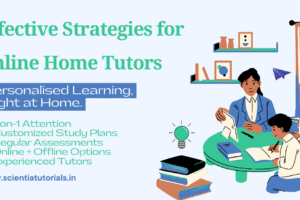Engaging Minds: Teaching Tips for Home Tutors on Using Games and Puzzles to Reinforce Learning Concepts
Introduction
In the realm of education, making learning enjoyable and engaging is crucial, especially for home tutors working with students of varying ages and abilities. One of the most effective ways to achieve this is by incorporating games and puzzles into lessons. Not only do these activities stimulate interest, but they also reinforce learning concepts in a fun and interactive way. This article will explore teaching tips for home tutors on effectively using games and puzzles to enhance educational outcomes, keeping students engaged and motivated.
The Importance of Play in Learning
Understanding the Role of Play
Play is a fundamental aspect of childhood development. It is through play that children explore, experiment, and learn about the world around them. Research indicates that play-based learning can improve cognitive skills, enhance creativity, and develop critical social skills. By integrating games and puzzles into tutoring sessions, home tutors can leverage the natural learning power of play.
Benefits of Using Games and Puzzles
- Enhanced Engagement: Games capture students’ attention, making learning enjoyable and less intimidating.
- Active Learning: Engaging in games requires students to think critically and make decisions, reinforcing concepts actively rather than passively.
- Immediate Feedback: Games often provide instant feedback, allowing students to understand their mistakes and learn from them right away.
- Social Skills Development: Many games encourage collaboration, communication, and teamwork, fostering essential social skills.
- Increased Retention: The fun and interactive nature of games helps improve memory retention, making it easier for students to recall information later.
Choosing the Right Games and Puzzles
Assessing Student Needs
Before introducing games and puzzles into lessons, it’s essential to assess your students’ needs, preferences, and learning styles. Consider their age, interests, and the specific concepts you aim to reinforce. Tailoring activities to suit individual learners can significantly enhance their engagement and understanding.
Selecting Appropriate Activities
Choose games and puzzles that align with the learning objectives. Here are some categories and examples:
- Board Games: Games like Scrabble or Boggle can help reinforce vocabulary and spelling skills.
- Card Games: Math card games can make practicing arithmetic fun and engaging.
- Puzzle Games: Jigsaw puzzles can promote problem-solving skills and teamwork.
- Online Games: Interactive educational websites and apps can provide instant feedback and are often designed for various subjects.
Integrating Games into Lesson Plans
Setting Clear Objectives
When incorporating games into lessons, it’s vital to set clear educational objectives. Determine what concepts you want to reinforce and how the game aligns with those goals. For example, if you’re focusing on addition and subtraction, choose a game that requires students to solve math problems to progress.
Balancing Fun and Learning
While the primary goal is to reinforce learning concepts, it’s crucial to maintain a balance between fun and educational content. Ensure that the game or puzzle provides opportunities for critical thinking and learning without becoming purely recreational.
Structuring Game Time
To maximize the effectiveness of game-based learning, structure game time strategically within your lessons:
- Introduction: Briefly explain the rules of the game and how it relates to the learning objectives.
- Active Participation: Encourage all students to participate actively, fostering a sense of teamwork and collaboration.
- Reflection: After the game, hold a discussion to reflect on what students learned. Ask questions to help them connect the game to the lesson concepts.
Adapting Games for Different Learning Styles
Visual Learners
Visual learners benefit from seeing information presented in charts, diagrams, and visual aids. Incorporate games that involve visual elements, such as:
- Memory Matching Games: Create cards with words and images that students can match.
- Board Games with Colorful Designs: Games with vibrant visuals can capture the attention of visual learners.
Auditory Learners
Auditory learners grasp concepts better through listening and verbal communication. Choose games that emphasize discussion and communication, such as:
- Storytelling Games: Encourage students to create and tell stories based on game scenarios.
- Rhyming Games: Use games that involve singing, rhyming, or verbal wordplay to reinforce language skills.
Kinesthetic Learners
Kinesthetic learners thrive on hands-on activities. Engage them with games that require movement or manipulation, such as:
- Interactive Math Games: Use physical objects like blocks or counters to solve problems.
- Outdoor Learning Activities: Incorporate games that require physical activity, like scavenger hunts related to the subject matter.
Encouraging Collaboration and Teamwork
Group Activities
Utilizing group games fosters collaboration and teamwork among students. Group activities can help students develop essential social skills, such as communication and conflict resolution. Here are some effective group game ideas:
- Team Trivia: Organize trivia games where students work in teams to answer questions related to the lesson.
- Collaborative Puzzles: Provide puzzles that require students to work together to complete them, promoting cooperation.
Encouraging Peer Teaching
Games can also serve as opportunities for peer teaching. Encourage students to take on different roles during the game, allowing them to explain concepts to one another. This collaborative approach reinforces learning and builds confidence in their understanding of the material.
Incorporating Technology in Game-Based Learning
Educational Apps and Websites
In today’s digital age, incorporating technology into learning is essential. Many educational apps and websites offer interactive games designed to reinforce learning concepts across various subjects. Consider integrating these tools into your tutoring sessions to enhance engagement and provide immediate feedback.
Virtual Learning Environments
If you’re conducting remote tutoring, explore virtual learning environments that offer game-based learning experiences. Platforms like Kahoot! and Quizlet allow tutors to create interactive quizzes and games that students can participate in from home. This technology-driven approach can make learning more accessible and enjoyable.
Assessing Learning Outcomes
Monitoring Progress
As you integrate games and puzzles into your tutoring sessions, it’s crucial to monitor students’ progress continually. Keep track of their performance during games and note areas where they excel or struggle. This data can inform future lesson planning and help you adjust your approach as needed.
Gathering Feedback
After each game or activity, ask students for feedback about their experience. Encourage them to share what they enjoyed, what they learned, and any challenges they faced. This feedback not only helps you gauge the effectiveness of the game but also empowers students by giving them a voice in their learning journey.
Overcoming Challenges
Managing Distractions
While games can enhance learning, they can also lead to distractions. To keep students focused, establish clear rules and expectations before starting a game. Set time limits and provide breaks as needed to maintain engagement without overwhelming students.
Addressing Varying Skill Levels
In a home tutoring setting, you may encounter students with varying skill levels. Choose games that can be easily adapted to accommodate different abilities. Consider modifying the rules or providing additional support to ensure all students can participate and benefit from the activity.
Conclusion
Incorporating games and puzzles into home tutoring sessions is an effective strategy for reinforcing learning concepts while keeping students engaged and motivated. By understanding the importance of play in learning, selecting appropriate activities, and structuring lessons thoughtfully, home tutors can create a dynamic and enjoyable educational experience. As tutors embrace the power of games and puzzles, they not only enhance academic outcomes but also foster a lifelong love for learning in their students. The journey of education is most rewarding when it is both fun and meaningful, paving the way for future success.



